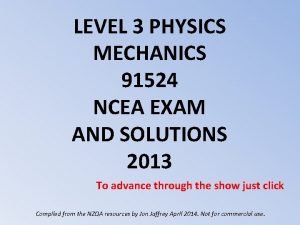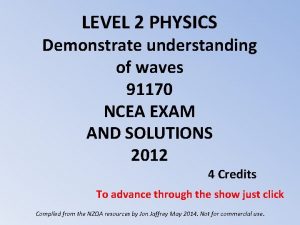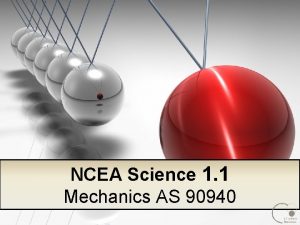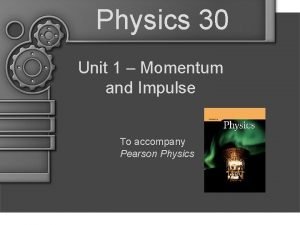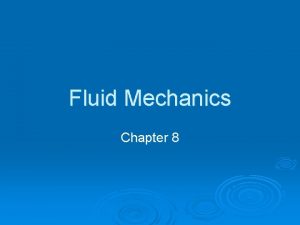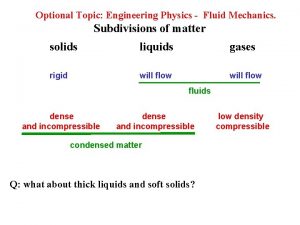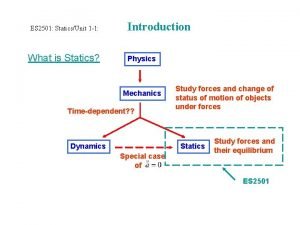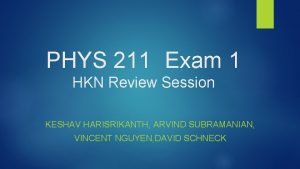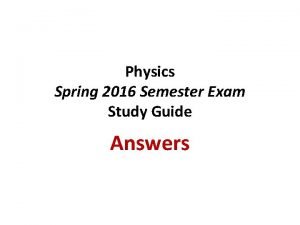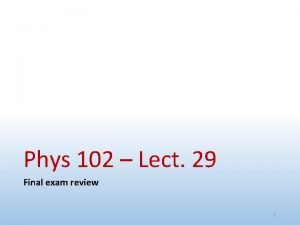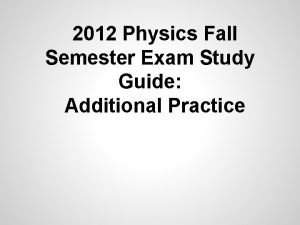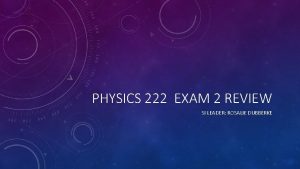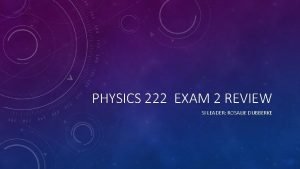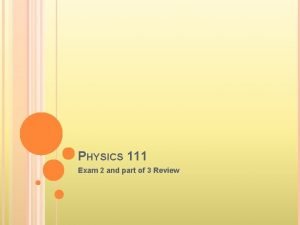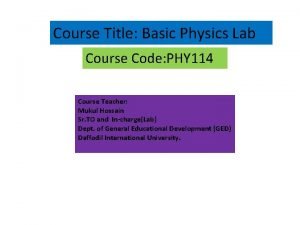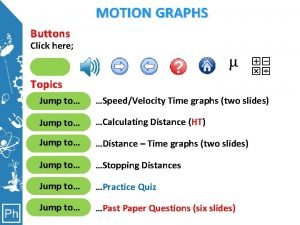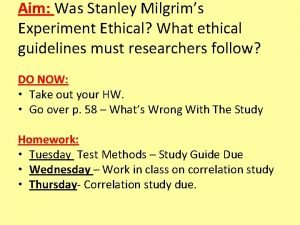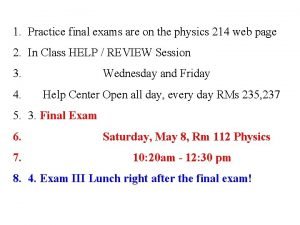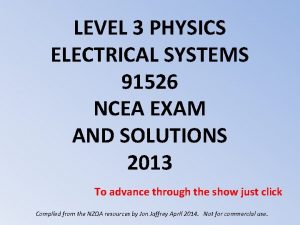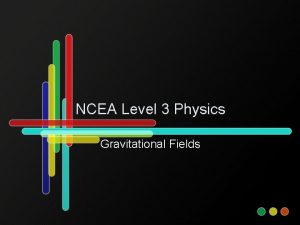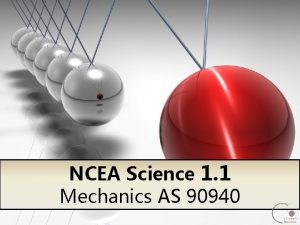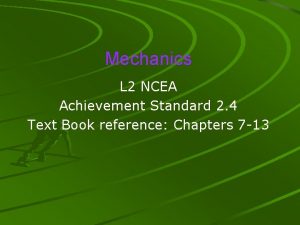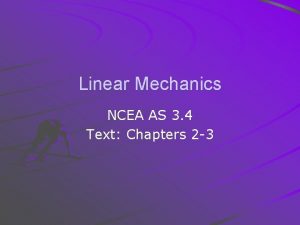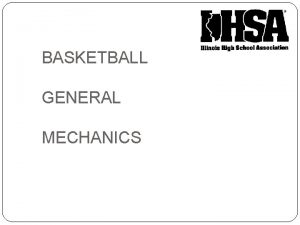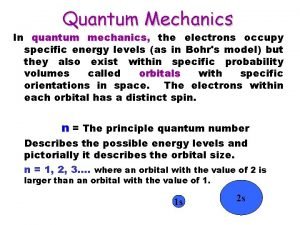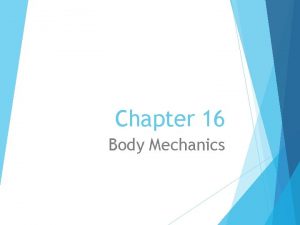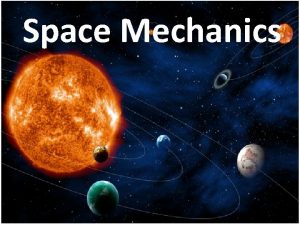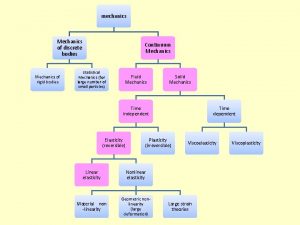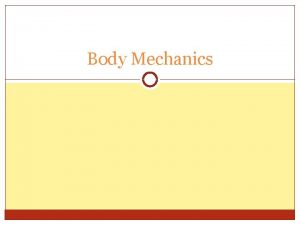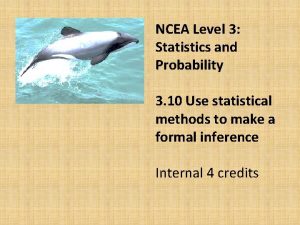LEVEL 3 PHYSICS MECHANICS 91524 NCEA EXAM AND
































- Slides: 32

LEVEL 3 PHYSICS MECHANICS 91524 NCEA EXAM AND SOLUTIONS 2013 To advance through the show just click Compiled from the NZQA resources by Jon Jaffrey April 2014. Not for commercial use.

QUESTION ONE: TOSSING BALLS A hollow ball has a mass of 0. 310 kg and radius 0. 0340 m. The ball is thrown vertically upwards from rest. It rises 1. 40 m through a height of 1. 40 m then drops down again. When it is released, it is moving upwards at 5. 24 m s-1 and rotating at – 1 2. 70 rev s 2. 70 revolutions per second. During the throwing action, a tangential force of 0. 480 N is 5. 24 m s– 1 applied to the surface of the ball for a period of 0. 250 s. (a) Show that the angular speed of the ball when it is released is 17. 0 rad s– 1 (b) Show that the average angular acceleration of the ball before it is released is 67. 9 rad s– 2. (c) Calculate the rotational inertia of the ball For the following two situations, explain whether the height to which the ball rises will be less than, greater than, or the same as 1. 40 m. Ignore the effects of air resistance. (d) (i) The ball is not rotating, but is given the same linear speed when it is released (ii) The ball is solid instead of hollow, but has the same mass and radius. The same amount of total work is done to give the ball its linear and rotational motion, and it has the same angular speed Solutions to Question ONE follow on the next slide:

GENERAL MARKING GUIDELINES FROM NZQA q An Excellence is worth at least one Merit (look at the Merit statements to see if it is worth more than one Merit) q A Merit is worth at least one Achieved (look at Achieved statements to see if it is worth more than one Achieved) q Symbols can be used in place of words in explanations for all levels q Accept in place of “gravitational force” – “weight” or “gravity” q Transcription errors (when you see the number they should have written, but there is a small change) – ACCEPT q Full correct substitution and wrong answer - ACCEPT FOR ACHIEVED, BUT DROP ONE MARK FOR MERIT AND EXCELLENCE (Use this rule if they forget the x 10? multiplier on an answer)

Schedule taken from NZQA for Question ONE (a) and (b) Q 1 Evidence (a) SHOW THAT QUESTION w = 2 f = 2 2. 70 w = 16. 965 = 17 rad s 1 Achievement 2 2. 70 Merit Excellence Can only get one “ACHIEVE” here OR working via 162 rpm (b) SHOW THAT QUESTION Or using 2. 7 x 2 x π = 0 + 0. 25 x α Correct working – equation and substitution Can only get one “ACHIEVE” here

(c) Calculate the rotational inertia of the ball Here we can use two equations, one to calculate the torque which creates the acceleration, then another to get the rotational inertia. First to get torque: Now to get I τ = Fr = 0. 48 x 0. 034 = 0. 01632 Nm τ = I α Gives I = 2. 405 x 10 -4 kg m 2 = 2. 41 x 10 -4 kg m 2 0. 01632 = 67. 86 I From NZQA schedule: Achievement with Merit Correct answer. (Unit not needed. ) Only one “MERIT” point available here. Can use I = 2 / 3 mr 2 All these get “ACHIEVE” so three points here Achievement with Excellence Both equations correct (or I = 2/3 mr 2 shown), with answer and unit (acceptable units: kg m 2, N m s 2, N m s 2 rad– 1, kg m 2 rad– 1) Correct working, answer, and unit for the “EXCELLENCE” point here Note: Using L = mvr gets N

Explain whether the height to which the ball rises will be less than, greater than, or the same as 1. 40 m. Ignore the effects of air resistance. (d) (i) The ball is not rotating, but is given the same linear speed when it is released Here the examiners are looking for an understanding of two concepts: Firstly that in both cases the ball’s linear kinetic energy is converted into gravitational potential energy. Since they both have the same amounts of linear Ek they both rise just 1. 4 m. Secondly the rotational component does not affect the situation. The rotating ball continues to rotate at the same rate in the absence of any external torques or air resistance (angular momentum is conserved!) Evidence statement from NZQA schedule: A ball thrown with the same linear speed will reach the same height, 1. 4 m. The balls both have the same linear kinetic energy, which turns into the same amount of gravitational potential energy. As a result the balls both reach the same height of 1. 4 m. The rotation of the ball does not affect the height because the rotating ball stays rotating at the same angular velocity, so the rotational kinetic energy does not change, so the gravitational potential energy is not affected. The next page from the NZQA schedule shows how they award the marks ……

Achievement Same height/ 1. 4 m Non rotating ball goes to a lower height because there is less EKtotal, so there is less EPgrav. Achievement with Merit Same height AND (linear kinetic energy is turned into gravitational potential energy OR Rotational kinetic energy does not change). Achievement with Excellence Linear kinetic energy is turned into gravitational potential energy, they have the same linear kinetic energy, so they reach the same height. AND angular velocity/rotational kinetic energy doesn’t change/affect the height The two balls have the same force / forces / acceleration acting, so reach the same height. OR The two balls have the same net The rotation does not affect the force / forces / force/ gravitational force acting, and acceleration so they reach the same height. the same initial speed, so they reach same height AND Two “MERIT” points Either gets “ACHIEVE” so angular velocity/rotational kinetic available here. only ONE point here energy doesn’t change/affect the height Two “EXCELLENCE” points here for clear reasoning of both the linear and rotational elements.

Explain whether the height to which the ball rises will be less than, greater than, or the same as 1. 40 m. Ignore the effects of air resistance. (ii) The ball is solid instead of hollow, but has the same mass and radius. The same amount of total work is done to give the ball its linear and rotational motion, and it has the same angular speed. Here the examiners are looking for three linked aspects of the problem: Firstly both balls are given the same amount of kinetic energy since both have the same amount of total work done on them. In both balls this will be split between linear and rotational kinetic energy. Secondly the solid ball has a smaller rotational inertia since its mass is concentrated closer to its centre of rotation. This means that for a given angular velocity it will have less rotational kinetic energy Ek. Rot = ½ Iω2. We are told the balls have the same angular speed. Thirdly if the solid ball has less of the total energy in rotational Ek then it will have more in linear Ek so more will be converted to gravitational potential energy, and so it will rise higher than the hollow ball. The next page from the NZQA schedule shows how they award the marks ……

Evidence statement from NZQA schedule: Because a solid ball has a significant proportion of its mass closer to the centre of rotation it would have a smaller rotational inertia than the hollow ball. If both balls are given the same angular speed the solid ball needs less work to get it rotating than the hollow ball. If less work is done to get the ball rotating, more of the total work is done to give the ball linear velocity so it will have a greater release speed and so will rise higher because it has more kinetic energy that is changed to gravitational potential energy Achievement v Solid ball has a smaller rotational inertia. Achievement with Merit Achievement with Excellence v Smaller rotational inertia because the Links – solid ball has smaller I solid ball has mass closer to the centre. because mass is closer to centre v Less work done / energy to get the of rotation therefore same spin of the solid ball OR more - EKrot is smaller – Work / Etotal is v Solid ball goes to a work / energy going into linear velocity the same for both therefore greater height. / linear energy of the solid ball. (or less - EKlin is greater – Eklin turns into replaced with more IF they think I gets EPgrav - therefore the ball goes bigger) higher. Either gets “ACHIEVE” so TWO v Less rotational kinetic energy because I is smaller (OR less replaced with more points here One “EXCELLENCE” point IF they think I gets bigger). here for clear reasoning of v Links linear kinetic energy to all linear and rotational gravitational potential energy to height elements. Two or three (even if height is incorrect). The next page from the NZQA “MERIT” points schedule shows how they award available here. Note: Accept “inertia”. the marks ……

NZQA JUDGEMENT STATEMENT FOR QUESTION ONE: Not Achieved Achievement with Merit N 1 N 2 A 3 A 4 M 5 ONE A point TWO A points THREE A points FOUR A points TWO M points There are 7 or 8 possible “ACHIEVE” bits you can get in the question. M 6 Achievement with Excellence E 7 E 8 THREE M ONE E point TWO E points from plus ONE M points two point from a different Out of three question part or four parts to the E points in (c) and (d) There are 5 or 6 possible “MERIT” bits you can get in the question from (c) or (d). “EXCELLENCE” can only be gained from detailed and correct answers in (c) and / or (d)

QUESTION TWO: SWINGING BALLS A ball on the end of a cord of length 1. 20 m is swung in a vertical circle. The mass of the ball is 0. 250 kg. When the ball is in the position shown in the diagram, its speed is 4. 00 m s-1. 4. 00 m s– 1 Acceleration due to gravity on Earth = 9. 81 m s– 2 1. 20 m (a) Calculate the size of the centripetal force acting on the ball at the instant shown in the diagram. (b) Explain why the ball moves fastest at the bottom of the circle.

QUESTION TWO continued (c) Diagram 1 shows the gravitational force acting on the ball at the top and bottom of the swing. (i) Assuming the tension force is non-zero at all points, draw vectors to show the relative sizes of tension forces at the top and bottom. (ii) Using the same scale, draw the centripetal force, on Diagram 2, at these two positions. Diagram 1 Top of the swing gravitational force Bottom of the swing Diagram 2

QUESTION TWO continued (d) Show that the minimum speed the ball must have during its circular motion is 3. 43 m s-1 at the top. Explain your answer 4. 00 m s– 1 (e) The ball drops to its minimum speed of 3. 43 m s– 1 at the top of the circle 1. 20 m Using conservation of energy, show that the angle at which the tangential speed of the ball is 4. 00 m s– 1, is θ = 34. 9°. Solutions to Question TWO follow on the next slide:

Schedule taken from NZQA for Question TWO (a) and (b) Evidence (a) (b) The total amount of kinetic and gravitational potential energy of the ball is conserved. As the ball goes down the gravitational potential energy is changed into kinetic energy. At the bottom of the circle the ball has the least gravitational energy so it has the greatest amount of kinetic energy, therefore it must be moving fastest here. Achievement Merit v Correct answer OR correct working (equation and substitution) v Maximum/high speed linked to maximum/high kinetic energy. v Gravitational force/weight has sped the ball up as it goes down v Centripetal force/Net force is greater at the bottom, so velocity is higher v Gravitational potential energy at the top is converted to kinetic energy. OR Statement of conservation of energy, and mentions GPE and KE. v Gravitational potential energy at the top is CHANGED into kinetic energy at the bottom so it goes faster. OR Energy is conserved. At the bottom the gravitational potential energy is the smallest, so the kinetic energy is the largest, therefore it goes faster at this point. Possibly 3 or 4 “ACHIEVE” points here One “ACHIEVE” mark here v There is a tangential force which accelerates the ball as it goes down Two “MERIT” points here

(c) (i) and (ii) Assuming the tension force is non-zero at all points, draw vectors to show the relative sizes of tension forces at the top and bottom. At the top of the swing we have to put in a small tension force directed towards the centre. This adds to gravity to give the centripetal force. The centripetal force at the top is the small tension force plus the force of gravity. At the bottom of the swing the tension is much bigger. It both counteracts the force of gravity and provides an upwards centripetal force. Using the same scale, draw the centripetal force, on Diagram 2, at these two positions The centripetal force at the bottom is the large tension force minus the force of gravity. The next page adapted from the NZQA schedule shows how they award the marks ……

(c) (i) Tension force (c) (ii) Centripetal force Achievement: Merit: v THREE vectors in correct directions. v Tension in correct directions, (larger at the bottom. ) OR Centripetal force in correct directions, (larger at the bottom). Two possible “ACHIEVE” marks here Excellence: All vectors in correct directions and (tension OR centripetal force) shown as larger at bottom. One “MERIT” mark All vectors in correct directions AND - tension larger at bottom than top - centripetal force at top is larger than tension or gravity - centripetal force at bottom is smaller than tension force at the bottom. One “EXCELLENCE” mark

(d) Show that the minimum speed the ball must have during its circular motion is 3. 43 m s-1 at the top. Explain your answer. Answer: We can now solve since: m = 0. 25 kg; r = 1. 20 m; g = 9. 81 ms-2 OR simplify v = 3. 4310 = 3. 43 ms-1 Although this is an Excellence question a fair stab at key bits can score good Achieve marks. A clear explanation of gravity providing Fc can get Merit and so will a good attempt at solving. It gets Excellence for a well explained correct answer. The next page adapted from the NZQA schedule shows how they award the marks ……

NZQA Assessment Schedule rearranged: Achieve: NZQA Evidence statement: At the top of the circle, where the speed is least, the centripetal force is the sum of the gravity force and the tension force. The minimum centripetal force is therefore when the tension force is zero and so the centripetal force is provided by the gravity force. Merit Out of 4 bullet points could get 2 or 3 “ACHIEVE” marks here. v Only force acting is the gravitational force OR gravitational force IS the centripetal force OR tension force = 0 therefore centripetal force = gravitational force 2 “MERIT” marks here. v Some correct working shown (equation OR substitution). Excellence: Correct working (equation AND substitution). AND gravitational force IS the centripetal force. OR tension force = 0, therefore centripetal force = gravitational force. Note: stating Fc = Fg is not the same as Fc IS Fg. Only ONE “EXCELLENCE” mark

(e) 4. 00 m s– 1 The ball drops to its minimum speed of 3. 43 m s– 1 at the top of the circle Using conservation of energy, show that the angle at which the tangential speed of the ball is 4. 00 m s– 1, is θ = 34. 9°. 1. 20 m Answer: This is a multistep Excellence question which is made a little easier by the hint to use conservation of energy. We can calculate the kinetic energies at the top and the point θ. The difference between these must be the gravitational potential energy lost going from this point up to the top. 0. 2155 m We know that the minimum Ek is at the top and we are given the velocity in the last question 3. 43 ms-1 So Ek = ½mv 2 gives us at the top: ½ 0. 25 x 3. 4312 = 1. 4715 J And Ek = ½mv 2 gives us at the point θ : ½ 0. 25 x 42 = 2 J Θ = 34. 870 1. 2 – 0. 2155 m 1. 2 m The next page adapted from the NZQA schedule shows how they award the marks ……

Taken from NZQA Assessment Schedule: Achieve: v Either EK calculated (at position shown (2 J) or at top(1. 41715 J)) v Correct EPgrav at top (from middle of circle = 2. 943 J or from bottom of circle 5. 886 J) v OR Difference in EPgrav = 0. 5285 J Out of 3 bullet points could get 2 or 3 “ACHIEVE” marks here. Merit: v A correct height – (0. 2155 from top, or 0. 9835 from middle or 2. 1835 from bottom). Note: Doesn’t have to explain where this is measured from One “MERIT” mark here. A height using EPgrav = 2 J (0. 815 m) or EPgrav = 1. 47 J (0. 599 m) is not acceptable. Excellence: Correct working – Some evidence of Epgrav and EK equations used and trig used. Only ONE “EXCELLENCE” mark The next page adapted from the NZQA schedule shows how they award the marks ……

NZQA JUDGEMENT STATEMENT FOR QUESTION TWO: Not Achieved N 1 N 2 ONE A point TWO A points Achievement A 3 A 4 Achievement with Merit M 5 M 6 THREE A FOUR A TWO M points from two from three different question parts There are 9 or 10 possible “ACHIEVE” bits you can get in the question but you need to get marks from different parts. THREE M points Achievement with Excellence E 7 E 8 ONE E point TWO E plus ONE M points point from a different Out of three question part points in (c) to the E point (d) and (e) There are 6 “MERIT” bits you can get in the question from (b) (c) (d) or (e). “EXCELLENCE” can only be gained from detailed and correct answers in (c) (d) or (e)

QUESTION THREE: OSCILLATING BALLS A ball, attached to a cord of length 1. 20 m, is set in motion so that it is swinging backwards and forwards like a pendulum. 1. 20 m (a) Show that the period of a pendulum of length 1. 20 m that is oscillating in simple harmonic motion is 2. 20 s (b) Explain what must be done to ensure that the motion of the ball approximates simple harmonic motion (c) On the axes below, sketch a graph to show what happens to the ball’s total energy over time until it stops swinging Energy Time

QUESTION THREE continued (d) It is possible to get the ball swinging by holding the top end of the cord and gently shaking it backwards and forwards. Explain how shaking the top end of the cord can make the ball on the bottom of the cord oscillate in simple harmonic motion. In your answer, you should consider resonance and energy transfer (e) Simple harmonic motion requires a restoring force that changes in proportion to the size of the displacement Discuss what provides the restoring force when the ball is swinging in simple harmonic motion. In your answer, you should: L (i) describe what forces act on the ball (ii) explain how these forces change as the ball swings y (iii) draw vectors to show a restoring force is produced Solutions to Question TWO follow on the next slide:

(a) Show that the period of a pendulum of length 1. 20 m that is oscillating in simple harmonic motion is 2. 20 s ACHIEVE for the right equation or substitution shown (b) Explain what must be done to ensure that the motion of the ball approximates simple harmonic motion. Answer: Simple pendulums only perform SHM if the angle of swing is small so the amplitude is small. For small angles the approximations which treat the movement as a straight line are good. Two ACHIEVE points One MERIT mark for here given for the ideas listed below v Angle / amplitude must be kept small. v The motion can be approximated to a straight line OR force / acceleration is proportional to displacement OR force / acceleration is towards the equilibrium position. Angle / amplitude / initial displacement is small AND the ball’s motion can be approximated to a straight line OR force / acceleration is proportional to displacement OR force / acceleration is towards the equilibrium position.

(c) On the axes below, sketch a graph to show what happens to the ball’s total energy over time until it stops swinging The total energy of the pendulum is the sum of the potential and kinetic energies. This gradually reduces as energy is lost through friction etc. largely as heat. Energy Time One ACHIEVE mark here for the shapes listed below v Downwards sloping line. v Oscillation with constant period that decreases with time. One MERIT mark for Line has negative slope with a decreasing size of slope.

(d) It is possible to get the ball swinging by holding the top end of the cord and gently shaking it backwards and forwards. Explain how shaking the top end of the cord can make the ball on the bottom of the cord oscillate in simple harmonic motion. In your answer, you should consider resonance and energy transfer Answer: Shaking the cord gently can transfer energy to the ball to start it swinging. This process is most effective if the shaking is done at the natural frequency of the pendulum. It will then resonate and it will swing more and oscillate at its natural frequency. This is how a child on a swing can move the swing more. This is an “Excellence” question but there are “Achieve” marks for some of the key ideas. Three ACHIEVE points here for these ideas v Shake at (resonant frequency OR natural frequency OR same time each cycle). v EPgrav ≤ ≥ EK as ball oscillates. v Standing wave set up (or words describing this). Schedule for Merit and Excellence are on the next slide …. .

(d) continued MERIT marks are given for these ideas v Shaking at (resonant frequency OR natural frequency OR same time each cycle). AND will cause (large amplitude OR large energy transfer OR energy transferred from shake to ball ). v Wave reflects / interferes and standing wave is set up. v Shake at (resonant freq OR natural freq OR same time each cycle) AND (EPgrav ≥ EK as ball oscillates OR statement of conservation of energy). v Force of hand pulls ball (increasing speed / acc / restoring force / amplitude OR causing acceleration / restoring force). EXCELLENCE for a clear explanation which includes Shaking at (resonant frequency OR natural frequency OR same time each cycle). AND Causes (energy to be transferred from shake to EPgrav or EK of ball OR wave reflects and interferes producing standing wave).

(e) Simple harmonic motion requires a restoring force that changes in proportion to the size of the displacement Discuss what provides the restoring force when the ball is swinging in simple harmonic motion. In your answer, you should: Tension (i) describe what forces act on the ball (ii) explain how these forces change as the ball swings Gravitational force (iii) draw vectors to show a restoring force is produced Answer: The forces acting on the ball are the tension in the string and the force of gravity. The force of gravity remains constant and vertically downwards. The tension force changes its angle throughout the swing. At the centre of the swing it increases since it both cancels gravity and provides a centripetal force. T G The restoring force is the unbalanced component at a tangent to the swing. This increases as the amplitude increases and is always directed to the centre of the swing. This is why it is SHM. The next pages adapted from the NZQA schedule show they award the marks ……

The marking for this is quite complex. An “ACHIEVE” mark can be given for Two “MERIT” marks can be given for: v Gravitational force and tension identified as forces acting on the ball. (Symbols sufficient) v Gravitational force does not change Note: Accept air resistance included v Gravitational force and tension named and labelled diagram of tension at correct non-zero angle and gravitational force acting downwards. No incorrect forces (e. g. Fc). v Tension increases displacement decreases because the centripetal force is greater because it is moving faster (curved) OR Tension increases as displacement decreases as tension force cancels a component of gravity OR Tension decreases as displacement decreases as horizontal component of tension gets smaller (straight line) OR Tension decreases as displacement decreases as vertical component cancels gravitational force (straight line) OR Tension changes angle as it always acts towards the cord OR (Restoring force is component of (tension or gravitational force) AND restoring force increases with greater angle)

EXCELLENCE Labelled diagram showing restoring force created (with triangle OR components OR statement showing restoring force is the addition of gravitational force and tension). No incorrect forces (e. g. Fc). AND Tension increases displacement decreases because the centripetal force is greater because it is moving faster OR Tension increases as displacement decreases as tension force cancels a component of gravity OR Tension decreases as displacement decreases as horizontal component of tension gets smaller OR Tension decreases as displacement decreases as vertical component cancels gravitational force OR Tension changes angle as it always acts towards the cord OR (Restoring force is component of (tension or gravitational force) AND restoring force increases with greater angle) Note: Accept air resistance included. The next page adapted from the NZQA schedule shows how they award the marks ……

NZQA JUDGEMENT STATEMENT FOR QUESTION THREE : Not Achieved N 1 N 2 ONE A point TWO A points Achievement A 3 A 4 Achievement with Merit M 5 M 6 Achievement with Excellence E 7 THREE A FOUR A TWO M THREE M ONE E points from points plus ONE M from two from three different points from point from a different parts two different parts different question parts to the E point There are 9 or 10 possible “ACHIEVE” bits you can get in the question but you need to get marks from different parts. E 8 TWO E points There are 7 “MERIT” bits you can get in the question from (b) (c) (d) or (e). “EXCELLENCE” can only be gained from detailed and correct answers in (d) or (e) The next slide gives the overall NZQA judgement statement for the paper ……. .

Judgement Statement Score range Not Achieved Achievement 0 – 7 8 – 13 Two A 3 and an N 2 would just get “ACHIEVE” Achievement with Merit with Excellence 14 – 18 19 – 24 Two A 4 and an M 6 would get “MERIT” Two M 6 and an E 7 would just get “EXCELLENCE” Compiled from the NZQA resources by Jon Jaffrey April 2014. Not for commercial use.
 Ncea level 1 mechanics past papers
Ncea level 1 mechanics past papers Physics waves level 2
Physics waves level 2 Redox reactions ncea level 2
Redox reactions ncea level 2 Ncea
Ncea Structural mechanics exam questions
Structural mechanics exam questions Ncea
Ncea As90947
As90947 Decomposition reaction diagram
Decomposition reaction diagram Solubility rules ncea
Solubility rules ncea 90940 answers 2018
90940 answers 2018 Ncea 91165
Ncea 91165 Nzic past papers
Nzic past papers As90947
As90947 Momentum and impulse physics 30
Momentum and impulse physics 30 Classical mechanics
Classical mechanics Beta positive decay
Beta positive decay Quantum physics vs mechanics
Quantum physics vs mechanics Simple physics ia ideas
Simple physics ia ideas Buoyancy force in fluid mechanics
Buoyancy force in fluid mechanics Physics mechanics
Physics mechanics What is statics
What is statics Physics 211 exam 1
Physics 211 exam 1 Physics semester 1 final exam study guide answers
Physics semester 1 final exam study guide answers Physics 20 final exam practice
Physics 20 final exam practice Physics 102 final exam
Physics 102 final exam Physics fall semester exam review
Physics fall semester exam review Physics 1 exam 2 review
Physics 1 exam 2 review Physics exam 2 review
Physics exam 2 review Physics 111 exam 2
Physics 111 exam 2 Physics 1 lab final exam
Physics 1 lab final exam Horizonal
Horizonal Milgrims
Milgrims Physics 101 final exam
Physics 101 final exam
